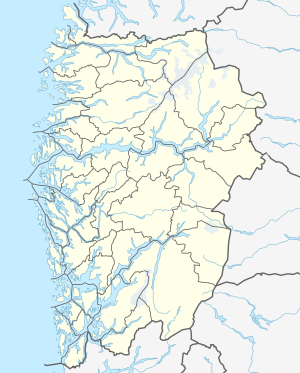Finsetunnel
| Finsetunnel | ||
|---|---|---|
|
Entry into the western snow superstructure in front of the Finsetunnel from the east
|
||
| use | Railway tunnel | |
| traffic connection | Bergensbanen | |
| place | Ulvik , Vestland | |
| length | 10,300 m | |
| Number of tubes | 1 | |
| construction | ||
| start of building | 1990 | |
| completion | 1993 | |
| business | ||
| operator | Jernbaneverket | |
| release | May 16, 1993 | |
| location | ||
|
|
||
| Coordinates | ||
| Hallingskeid west portal | 60 ° 39 ′ 1 ″ N , 7 ° 19 ′ 34 ″ E | |
| East portal Finse | 60 ° 36 ′ 13 ″ N , 7 ° 29 ′ 38 ″ E | |
The Finsetunnel ( Norwegian Finsetunnelen ) is a 10.3 km long railway tunnel west of the Finse station on the Bergensbane . It is located in the Ulvik municipality in Vestland .
history
The Finsetunnel is the longest of all tunnels in the route of the Bergensbane between Hønefoss and Bergen . Work on the tunnel began in 1990. The official opening by King Harald V took place on May 16, 1993. It is also Norway's third longest railway tunnel after the Lieråsen tunnel and Romeriksporten . With the concrete superstructures to protect against snow drifts, it is 10,589 meters long.
Before the tunnel was built, the trains ran over the mountain route via Fagernut. After the opening, the snow removal base in Finse was closed, and the snow removal teams have been deployed from Geilo and Myrdal ever since . The highest point of the Bergensbane is in the tunnel and is 1237.2 moh. ( German meters above sea level ). Before the tunnel was built, the highest point on the route was 1,301 moh. The tunnel shortened the route by 4.5 kilometers and reduced travel time by eight to ten minutes.
After the tunnel was opened, an eleven-kilometer stretch of road east of Finse was expanded and protected against drifting snow in order to achieve a higher travel speed.
In 2004 the tunnel was listed in a report highlighting potential safety problems in several Norwegian tunnels due to its length and difficult access for rescuers. According to this report, the tunnel has deficiencies in safety equipment , emergency lighting , communication facilities and escape routes . The report also criticized the lack of disaster exercises and the ability to evacuate the tunnel in the event of fire.
Individual evidence
- ↑ Thor Bjerke, Finn Holom: Banedata 2004 . Data from infrastructures to the railroad in Norway. Ed .: Jernbaneverket, Norsk Jernbanemuseum and Norsk Jernbaneklubb Forskningsavdelingen. NJK Forskningsavdelingen, Hamar / Oslo 2004, ISBN 82-90286-28-7 , urn : nbn: no-nb_digibok_2011040708010 (Norwegian).
- ↑ In Norwegian , the ending "-en" for nouns is a definite article . Therefore, the correct designation in German texts is either "Bergensbanen" or "die Bergensbane".
- ↑ Finse. Jernbaneverket , accessed April 16, 2014 (Norwegian).
- ↑ Bergensbanen. (PDF) Jernbaneverket , archived from the original ; Retrieved February 13, 2016 (Norwegian).
- ↑ Tom Arne Moe: Farlige jernbanetunneler. Bare 6 av de 93 jernbanetunnelene i Hordaland has beredskapsplaner . nrk Hordaland, September 2, 2004, accessed April 16, 2014 (Norwegian).
Web links
- Finsetunnelen i openstreetmap.org
- Fin tunnel. In: Store norske leksikon . Retrieved April 16, 2014 (Norwegian).

